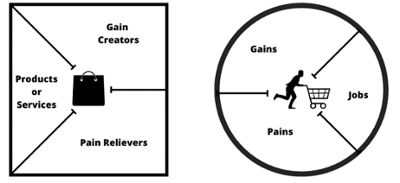Types of business models in less than 800 characters
Have you ever heard of business models? This concept is quite old, it was introduced at the beginning of the 20th century. The oldest business model...
By Role
By Industry
By Target Customer
What We Offer
We drive business growth by improving operational efficiency through process optimization, smart automation, and cost control. Our approach boosts productivity, reduces expenses, and increases profitability with scalable, sustainable solutions
Customer Experience
We design memorable, customer-centered experiences that drive loyalty, enhance support, and optimize every stage of the journey. From maturity frameworks and experience maps to loyalty programs, service design, and feedback analysis, we help brands deeply connect with users and grow sustainably.
Marketing & Sales
We drive marketing and sales strategies that combine technology, creativity, and analytics to accelerate growth. From value proposition design and AI-driven automation to inbound, ABM, and sales enablement strategies, we help businesses attract, convert, and retain customers effectively and profitably.
Pricing & Revenue
We optimize pricing and revenue through data-driven strategies and integrated planning. From profitability modeling and margin analysis to demand management and sales forecasting, we help maximize financial performance and business competitiveness.
Digital Transformation
We accelerate digital transformation by aligning strategy, processes and technology. From operating model definition and intelligent automation to CRM implementation, artificial intelligence and digital channels, we help organizations adapt, scale and lead in changing and competitive environments.
Operational Efficiency
We enhance operational efficiency through process optimization, intelligent automation, and cost control. From cost reduction strategies and process redesign to RPA and value analysis, we help businesses boost productivity, agility, and sustainable profitability.
Customer Experience
Marketing & Sales
Pricing & Revenue
Digital Transformation
Operational Efficiency
5 min read
Por Sergio Gutierrez | Jun 05, 2025
5 min read
Por Sergio Gutierrez | Jun 05, 2025
If you have any knowledge of Business Model Canvas you will know that it is a powerful tool that helps you to structure the backbone of your business, it teaches you to build solid and robust foundations for its construction to be successful.
By "zooming in" on each block that makes it up, you can work on and improve them individually, but what you may not know is that the same authors who created it also developed a useful tool to design and improve a product or service by "zooming in" on two of these blocks simultaneously. In this blog we are going to talk about the Value Proposition Canvas, with which you can enhance the results of your Business Model Canvas by dedicating your efforts to generating value for your customers, which will make your business more attractive to your competition because not everyone knows of its existence.
Index
First of all, I recommend you review what a Business Model Canvas is, as it is composed of the nine blocks of a business model, and you will get a better idea of where the Value Proposition Canvas comes from. The latter uses as main inputs the market segment and the value proposition, with which it forms its two components:
I invite you to read this blog to get a better understanding of the Business Model Canvas: Business Model Fundamentals: What do you need to know?
So, what is the Value Proposition Canvas? We are talking about a tool that will help you compare a value proposition against a market segment, with the aim of instructing you in the design of a product or service that not only works for your potential customers, but also solves their problems and generates additional benefits that make them prefer you over your competition.

The way it works is simple, first the Value Map is placed on one side and the Customer Profile on the other, then these are divided into three, then each division is completed with the respective characteristics of each component, and finally it is a matter of looking at the big picture to combine the two parts. The idea is that the product or service performs the tasks the customer requires, that the pain relievers eliminate or reduce their discomfort and that the profit generators create extra benefits that will let them know you see beyond their needs. The result is a canvas that allows you to visualize the diagram in a simple and orderly way.
Read more: What is the Value Proposition Canvas and what is it for?
The creators of the tool themselves mention its uses, which you can find in the book "Value Proposition Design". Its essence is to help you design a product or service that is functional, comfortable and with added value that attracts your potential customers. But how do you achieve this goal? Well, it's simple, through three basic functions.
I recommend this blog to learn how to create a Value Proposition Canvas as soon as possible: How To Fill In A Value Proposition Canvas

The Value Proposition Canvas can be used either to create a value proposition from scratch or to improve an existing one. In fact, it is a good practice to review it periodically to keep improving and adapting it, as customers' consumption habits tend to change over time.
The creators of the tool also mention situations in which it will be useful for you. Below, I summarize some of them so that you can decide for yourself if it is a good idea to implement it in your business model.
As you can see more than a complement to your business, it could even serve you as a tool for prevention, which also helps you to start off on the right foot. For that reason, there are few and specific occasions in which it will be of little use to you, perhaps in those products or services that are black holes, that is, that are produced or provided by so many companies that it is difficult for any differentiator to make them stand out from the rest (such as a new toilet paper, toothbrushes, mobile phones, pens, room cleaning or haircuts). In these cases, it might be worth trying other tools such as Blue Ocean or TRIZ to identify how an innovative idea could make an impact in these markets.

I think that, once you have reached this point, you already have an idea of the benefits for your team, for your product or service or for your customers that the simple fact of implementing this tool can bring you. However, here are three benefits that you may not have thought of and are important to take into consideration.


Have you ever heard of business models? This concept is quite old, it was introduced at the beginning of the 20th century. The oldest business model...

This article arises after asking the following questions:Who doesn't like to improve? Who doesn't seek optimization in their daily tasks? Is there...

Magento is a robust eCommerce solution that has consolidated itself as one of the industry leaders and is quickly growing in popularity amongst...